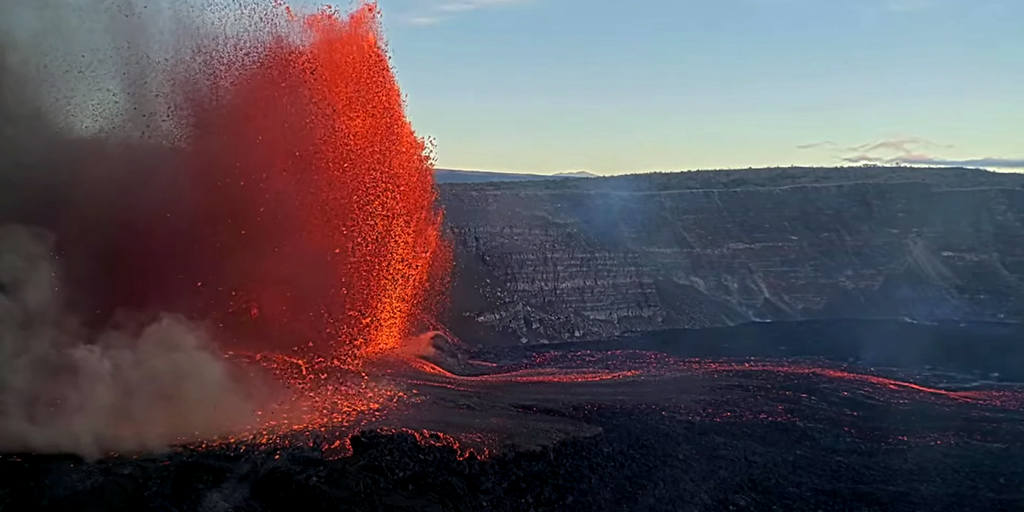Mount Kilauea: Life Amid the Lava
In the early hours of Wednesday, Hawaii Volcanoes National Park awoke to the crackling roar of Mount Kilauea, its fiery heart once again punctuating the tranquility of the landscape. As lava fountains erupted to heights of 150 feet, the air was thick with anticipation and a touch of dread. The volcano, known for its mercurial temperament and beauty, has become an arena where nature’s raw power plays out, reminding all who witness it of humanity’s fragile existence against the forces of the Earth.
The Phenomenon of Kilauea
Since December 23, Kilauea has been exhibiting intermittent eruptions, signaling its 28th phase of activity. The U.S. Geological Survey (USGS) reported that this latest episode represents a vent overflow, with the potential for more explosive displays. While the current fountains are modest compared to historical figures—where lava spewed as high as 1,000 feet—geologists remain on high alert.
“We have learned never to underestimate Kilauea,” says Dr. Lani Mahelona, a volcanologist at the Hawaiian Institute of Geoscience. “The volcano can shift in a moment, and what we’re seeing now could be just the prelude to something much more potent.”
Hazards of Eruptive Episodes
While the spectacle draws onlookers and scientists alike, it is imperative to understand the inherent dangers. The current eruption occurs within a carefully closed-off area of the national park, meant to protect both visitors and wildlife from toxic volcanic gases, such as sulfur dioxide. These gases can have long-lasting impacts on air quality, especially downwind of the volcano.
- Hazardous Gases: Sulfur dioxide and particulates can lead to respiratory problems.
- Pele’s Hair: Extremely fine volcanic glass strands that can travel over ten miles.
- Volcanic Ash: This can disrupt air travel and impact health and agriculture.
Dr. Samuel Ohi, an environmental scientist who studies the effects of volcanic activity, explains, “Air quality monitoring has become crucial during these eruptions. Even if you’re not near the volcano, the effects can be felt miles away.” His research shows a marked increase in respiratory issues among residents during previous eruptions, highlighting the need for ongoing community support and preparedness.
The Enigmatic Beauty of Volcanoes
For many, the allure of Kilauea is not just in its destructive power but also in its stunning beauty. The phenomenon known as Pele’s hair—a term derived from the Hawaiian goddess of fire—has attracted the attention of scientists and tourists alike. These delicate strands of volcanic glass are often ejected from lava fountains and can glisten in the sunlight, creating a surreal landscape.
“Pele’s hair presents an intriguing duality,” notes Dr. Mahina Kano, a cultural geographer. “While beautiful, it serves as a reminder that beauty and danger often coexist in nature. This is central to Hawaiian mythology and belief systems.”
Cultural Significance and Resilience
The eruptions of Kilauea are deeply rooted in the Hawaiian cultural landscape. Many locals regard the volcano as a living entity, one that embodies both the spirit of creation and destruction. They have learned to coexist with its active cycles, adapting their lives around its rhythms. Community gatherings and cultural ceremonies continue to occur, even in the shadow of eruptions, reinforcing the resilience of the Hawaiian people.
Dr. Kano emphasizes this connection: “Despite the physical dangers, Kilauea serves as an essential part of our identity. The eruptions are a time of renewal, and the community takes these moments to honor their rich heritage.”
The Future of Kilauea
The recent publicity surrounding the eruption has reignited debates about monitoring and safety regulations within national parks. As volcanoes continue to exhibit unpredictability, the need for sophisticated monitoring systems has never been more evident. The USGS has raised the alert level to orange, signaling escalated unrest and an increased likelihood of more explosive events.
In a hypothetical study conducted by the University of Hawaii, researchers have found that the patterns of Kilauea’s activity could provide crucial insights into volcanic behavior worldwide. The study proposes a model for predicting eruptions based on seismic activity and gas emissions, hoping to minimize risk not only for Hawaii but for vulnerable regions worldwide.
Community Preparedness and Education
The local government and organizations have ramped up efforts to educate both residents and tourists about the potential hazards associated with volcanic eruptions. Ongoing workshops, safety drills, and informative campaigns have become essential in equipping the community for future eruptions.
“Preparedness is vital,” insists Dr. Ohi. “People need to be informed not just about the beauty of Kilauea but also about the risks. We have to strike a balance between showcasing our unique surroundings and ensuring safety.”
As the sun sets over Kilauea, casting a warm glow on the bubbling lava, a sense of unity envelops the gathering crowds. They come together not just to witness the power of nature but to celebrate a culture that thrives on adaptability and resilience. In the midst of chaos, they find a harmony that transcends fear, reaffirming their bond to the land and each other. Each eruption, a poignant reminder of life’s transient beauty and the unwavering spirit of those who call Hawaii home.









